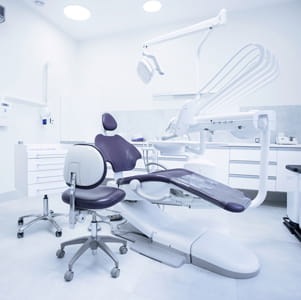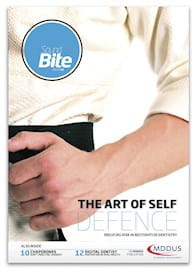
ALLEGATIONS of inappropriate behaviour have not been far from the headlines in recent months, so what better time to reflect upon the arrangements we make in dental practice for chaperoning?
The English word ‘chaperone’ was first recorded in the 15th century and originally meant ‘hood for a hawk’, later referring to ‘an older woman who protects a young unmarried female.’ The dental surgery is hardly like a scene from Pride and Prejudice, with a dental nurse awkwardly listening in to what is going on whilst pretending to be invisible – or at least it shouldn’t be.
The term chaperoning is commonly used when we think about protecting patients and ourselves from accusations of ‘boundary transgressions’. But the role of chaperone – or what is commonly referred to in dentistry as a chairside assistant – encompasses a far greater range of responsibilities.
Appropriate support
Aside from the practicalities of delivering care to an upper 7 unaided, and providing an extra pair of hands so we have a chance of reaching old age with our backs intact, chairside assistance provides for: a second person in medical emergencies; a witness to what is said and done; reassurance for the patient; and physical protection for both.
The rise in dental litigation should have sensibly seen the end to practising dentistry unaided, and yet we take calls daily from members of the dental team querying whether they can work alone. Traditionally, hygienists and therapists have been expected to work without a designated dental nurse, and often business reasons are quoted for the lack of chairside assistance being provided. Whilst we live in the real world where staffing comes at a cost, the financial practicalities of running a business have to be balanced against the risks of working unassisted.
The General Dental Council’s Standards for the dental team states that “you must be appropriately supported when treating patients”. Their use of the term ‘must’ means this is non-negotiable. But what do they mean by ‘appropriately supported’? One might imagine that a nurse only popping in to clear away instruments for the LDU was not the intention behind their drafting. The Standards go on to say “you should work with another appropriately trained member of the dental team at all times when treating patients in a dental setting.” The only circumstances they say this doesn’t apply are when:
- Treating patients in an out-of-hours emergency
- Providing treatment as part of a public health programme
- There are exceptional circumstances.
The GDC define exceptional circumstances as “not routine and could not have been foreseen”, pointing out that “absences due to leave or training are not exceptional circumstances.”
The use of the word ‘should’ in the GDC’s guidance above does mean that there may be circumstances when a dentist could treat a patient unassisted. Any practitioner would be expected to be able to demonstrate that they considered the particular patient, procedure and their own skills and experience before making the decision to work alone. That said, the GDC specifically indicate that they use the word ‘should’ when explaining how you will meet the overriding duty which is that you must be appropriately supported.
One of the overarching principles of the Standards is that dentists should “put patients’ interests before your own or those of any colleague, business or organisation”. Using financial circumstances to justify the nonprovision of chairside assistance could put the practitioner in breach of this.
Patient safety
Patient safety is paramount to the GDC who state: “You must not provide treatment if you feel that the circumstances make it unsafe for patients.” They are clear that there must be at least one other person available within the working environment to deal with medical emergencies when you are treating patients. It is for the individual practitioner to check, risk assess and decide whether the other person in the practice is appropriately trained for this purpose.
When deciding whether you can safely treat a patient alone, consideration must be given to how you would cope should a medical emergency arise. After all, we can’t always predict who will become unwell. Consider also how accessible the other person is. If you have to leave your patient, pass through doors and potentially go up or downstairs to summon assistance, what happens to the patient in the meantime? Clearly your second person needs to be rapidly accessible to fulfil any idea of patient safety.
Clinician safety
Assault and aggressive/threatening behaviour is thankfully rare, but it does happen. By working in an isolated environment without assistance, you may be placing yourself and/or your employee in an unnecessarily vulnerable position. How often do you leave a dental nurse alone with a patient? They are vulnerable to both allegations of inappropriate behaviour and potential assault. Where the dental care practitioner (DCP) is an employee, you may also be breaching your duty as an employer to look after their safety and wellbeing (under the Health and Safety at Work Act).
The Care Quality Commission (CQC), which regulates primary care dental services in England, has published a series of useful Dental mythbuster guidance articles, of which number 13 relates to lone working. It states that when inspectors judge whether or not lone working is safe they consider:
- GDC Standards Principal 6: Work with colleagues in a way that is in patients’ best interests
- The Health and Social Care Act 2008 (Regulated Activities) Regulations 2014, regulation 18 (staffing) and regulation 12 (safe care and treatment).
The CQC is clear that if inspectors found dental care professionals working alone, not in exceptional circumstances, they would be concerned. In addition, where chairside support from a dental nurse was not available, they would expect to see a risk assessment which has taken into account the medical emergency scenario for either the patient or the DCP. Their key question is: “How are risks to individual people who use the services assessed, and their safety monitored and maintained?”
Self-defence
Lastly, aside from complying with the relevant regulators, the presence of a chaperone can be helpful to a clinician when faced with accusations of misconduct. Whilst comprehensive records are crucial, who can honestly say their notes fully reflect everything that was said? Patient complaints frequently also include allegations about a clinician’s manner or attitude. In these instances the supporting witness statement of your dental nurse can be key. Clearly if they aren’t in the room, then you are very much on your own as records say little about a clinician’s demeanour.
The actress Greta Garbo once famously said that she “wants to be alone”. When work is hectic we may sympathise, but the days when that was either wise or safe may well have passed.
Rachael Bell is a dental adviser at MDDUS
This page was correct at the time of publication. Any guidance is intended as general guidance for members only. If you are a member and need specific advice relating to your own circumstances, please contact one of our advisers.
Read more from this issue of Insight Primary

Save this article
Save this article to a list of favourite articles which members can access in their account.
Save to library